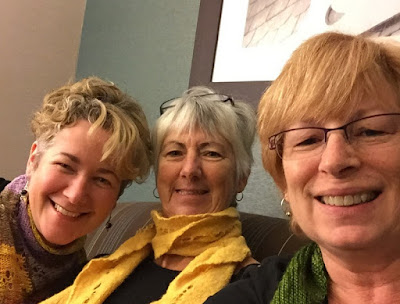Two of my friends named Jennifer (let's call them Jen1 and Jen2) and I travelled to the Hudson Valley last weekend to attend the
NY Sheep and Wool Festival at Rhinebeck, NY. It was their first time (much akin to taking children to Disneyworld for the first time) so they were in for a jaw-dropping, yarn encompassing, fibre-ly good time.
 |
| Jen1, Jen2 and Geri |
Jen2 wore her recently completed
'Les Mis' scarf for the occasion.
Upon arrival at our hotel, we checked in and lined up for the indie trunk show that was to take place in the ballroom from 5 to 9. Here we are at 4:32pm. The first 100 people got goodie bags. All of us got draw tickets for the doorprizes that had been donated by the vendors.
We met lots of nice folks in line - all as excited as we were. One
yarn shop owner from NJ organized a bus tour and had special bags printed for the occasion.
The door prizes were on tables outside the ballroom, each with a bag where the attendee deposits the door prize ticket. Half the items were drawn at 6:30 and the other half at 8pm. We went for dinner between drawings.
Inside the ballroom were many vendors with many lovely items. Here is a sampling of what was available:
Color Purl hand-dyed gradients,
Vivid Fiber Arts had a beautiful display (with no posted prices).
Each cube had its own LED light.
White Birch Fiber Arts had lots of nifty self-striping sock yarn with samples on display.
This Silver Spun yarn has silver filaments running through it - perfect for knitting gloves or tips of gloves with conductivity for people who like to check their devices without having to remove their gloves.
It was an excellent way to begin our weekend. There were SO many people, however. It is not for the faint of heart or claustrophobe. I'm not sure how the issue can be solved - more ballroom space? It has become a well-known precursor to the Festival in this, only its second year. But it's an excellent opportunity for smaller, independent fibre people to get exposure and reap the benefits of a captive audience.
The next morning we got up early to arrive at the Dutchess County Fairgrounds in time to get a parking spot close to the gate. This is very handy to drop off purchases during the day and in our case, we met there to have our lunch which we'd pre-planned and kept in a cooler in the car.
We were fairly close to the beginning of the lineup. This was the lineup ahead of us at 8:22am. Gates opened at 9. It was absolutely no problem buying our tickets at the gate. We had $3 off coupons, saving the service charge had we purchased them ahead of time online.
It was pretty nippy and windy but we knew to bundle up and dress in layers.
Clara Parkes was going to be giving away 100 copies of galleys of her book,
Knitlandia, which will be coming out next February. We knew to make a beeline over to building B to line up for the event.
The other authors are also behind tables along this narrow area. I bet they were glad when Clara's crowd left.
Jen1 sported her Mizzle shawl and I had on my Ruddington cardigan and Travelling Woman shawl.
Jen looked quite delighted as she was about to meet Clara, who chatted with each of us, complimented our knitwear, and autographed our free galleys.
We then fanned out with an agreed-upon meeting time for lunch.
Bijou Ranch had the most expensive ball of yarn I had ever seen. 1 ounce of vicuña yarn @ $300US! They also had 100% qiviut one-ounce balls for $167US. Eeek!
These rugs were crafted from felted balls of roving. They'd be very squishy to walk on I suspect.
Between buildings, I took an iconic autumnal shot.
And more autumnal shots.
Another fibre artist specialized in needle-felted works. This is one she did with trees.
And a closeup.
Back outside, I took a shot down the hill towards the vendors. It was a mass of people.
While at the Bitsy Knits booth, I found Mo! She was helping out for a couple of hours.
There are always pithy, fibre-ly sayings:
This one, I believe, is true.
We had a full, busy day and were very glad to get back to the hotel. Then we spread our respective booty out on the bed. I didn't buy a lot of stuff - mostly hand crafted fiber or items. But was very happy with what I came away with.
Our drive home the next day was uneventful. Lots of comfort stops and a bit of shopping in Watertown before crossing back onto Canada. We got Jen2 back home in Kingston and then got ourselves home to Whitby.
And then it was all over. The Jennifers were very easy to travel with, get along with, and were lots of fun.
Jen2 is already off on another adventure for a couple of weeks and Jen1 and I are looking forward to a knitting retreat in November.







